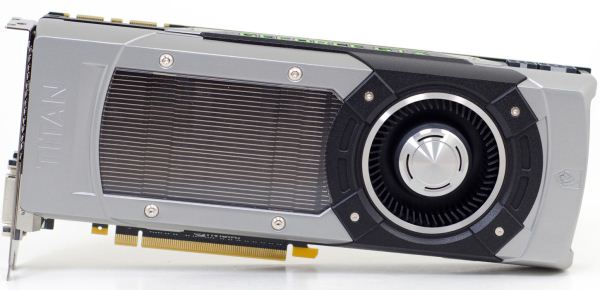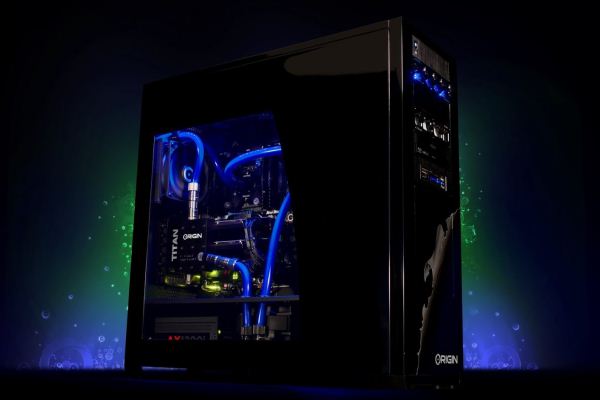NVIDIA’s GeForce GTX Titan Review, Part 2: Titan's Performance Unveiled
by Ryan Smith & Rahul Garg on February 21, 2013 9:00 AM ESTFinal Thoughts
Bringing things to a close, most of what we’ve seen with Titan has been a long time coming. Since the introduction of GK110 back at GTC 2012, we’ve had a solid idea of how NVIDIA’s grandest GPU would be configured, and it was mostly a question of when it would make its way to consumer hands, and at what clockspeeds and prices.
The end result is that with the largest Kepler GPU now in our hands, the performance situation closely resembles the Fermi and GT200 generations. Which is to say that so long as you have a solid foundation to work from, he who builds the biggest GPU builds the most powerful GPU. And at 551mm2, once more NVIDIA is alone in building massive GPUs.
No one should be surprised then when we proclaim that GeForce GTX Titan has unquestionably reclaimed the single-GPU performance crown for NVIDIA. It’s simply in a league of its own right now, reaching levels of performance no other single-GPU card can touch. At best, at its very best, AMD’s Radeon HD 7970GE can just match Titan, which is quite an accomplishment for AMD, but then at Titan’s best it’s nearly a generation ahead of the 7970GE. Like its predecessors, Titan delivers the kind of awe-inspiring performance we have come to expect from NVIDIA’s most powerful video cards.
With that in mind, as our benchmark data has shown, Titan’s performance isn’t quite enough to unseat this generation’s multi-GPU cards like the GTX 690 or Radeon HD 7990. But with that said this isn’t a new situation for us, and we find our editorial stance has not changed: we still suggest single-GPU cards over multi-GPU cards when performance allows for it. Multi-GPU technology itself is a great way to improve performance beyond what a single GPU can do, but as it’s always beholden to the need for profiles and the inherent drawbacks of AFR rendering, we don’t believe it’s desirable in situations such as Titan versus the GTX 690. The GTX 690 may be faster, but Titan is going to deliver a more consistent experience, just not quite at the same framerates as the GTX 690.
Meanwhile in the world of GPGPU computing Titan stands alone. Unfortunately we’re not able to run a complete cross-platform comparison due to Titan’s outstanding OpenCL issue, but from what we have been able to run Titan is not only flat-out powerful, but NVIDIA has seemingly delivered on their compute efficiency goals, giving us a Kepler family part capable of getting far closer to its theoretical efficiency than GTX 680, and closer than any other GPU before it. We’ll of course be taking a further look at Titan in comparison to other GPUs once the OpenCL situation is resolved in order to come to a better understanding of its relative strengths and weaknesses, but for the first wave of Titan buyers I’m not sure that’s going to matter. If you’re doing GPU computing, are invested in CUDA, and need a fast compute card, then Titan is the compute card CUDA developers and researchers have been dreaming of.
Back in the land of consumer gaming though, we have to contend with the fact that unlike any big-GPU card before it, Titan is purposely removed from the price/performance curve. NVIDIA has long wanted to ape Intel’s ability to have an extreme/luxury product at the very top end of the consumer product stack, and with Titan they’re going ahead with that.
The end result is that Titan is targeted at a different demographic than GTX 580 or other such cards, a demographic that has the means and the desire to purchase such a product. Being used to seeing the best video cards go for less we won’t call this a great development for the competitive landscape, but ultimately this is far from the first luxury level computer part, so there’s not much else to say other than that this is a product for a limited audience. But what that limited audience is getting is nothing short of an amazing card.
Like the GTX 690, NVIDIA has once again set the gold standard for GPU construction, this time for a single-GPU card. GTX 680 was a well-built card, but next to Titan it suddenly looks outdated. For example, despite Titan’s significantly higher TDP it’s no louder than the GTX 680, and the GTX 680 was already a quiet card. Next to price/performance the most important metric is noise, and by focusing on build quality NVIDIA has unquestionably set the new standard for high-end, high-TDP video cards.
On a final note, normally I’m not one for video card gimmicks, but after having seen both of NVIDIA’s Titan concept systems I have to say NVIDIA has taken an interesting route in justifying the luxury status of Titan. With the Radeon HD 7970 GHz Edition only available with open air or exotic cooling, Titan has been put into a position where it’s the ultimate blower card by a wide margin. The end result is that in scenarios where blowers are preferred and/or required, such as SFF PCs or tri-SLI, Titan is even more of an improvement over the competition than it is for traditional desktop computers. Or as Anand has so eloquently put it with his look at Falcon Northwest’s Tiki, when it comes to Titan “The days of a high end gaming rig being obnoxiously loud are thankfully over.”
Wrapping things up, on Monday we’ll be taking a look at the final piece of the puzzle: Origin’s tri-SLI full tower Genesis PC. The Genesis has been an interesting beast for its use of water cooling with Titan, and with the Titan launch behind us we can now focus on what it takes to feed 3 Titan video cards and why it’s an impeccable machine for multi-monitor/surround gaming. So until then, stay tuned.












337 Comments
View All Comments
vps - Thursday, February 21, 2013 - link
For compute benchmark you might want to take a look at FAHBenchFAHBench is the official Folding@Home GPU benchmark. It measures the compute performance of GPUs for Folding@Home.
http://proteneer.com/blog/?page_id=1671
Some reference scores are here:
http://foldingforum.org/viewtopic.php?f=38&t=2...
Ryan Smith - Thursday, February 21, 2013 - link
FAHBench is primarily an OpenCL benchmark (there's a CUDA path, but it's effectively on its way out). It's on our list, and is one of the things we couldn't run due to the fact that OpenCL is not currently working on Titan.Hrel - Thursday, February 21, 2013 - link
PowerDirector still uses CUDAatlr - Thursday, February 21, 2013 - link
Not sure if this helps. I found CLBenchmark results of a Titan versus a 7970 here.http://clbenchmark.com/compare.jsp?config_0=144702...
atlr - Thursday, February 21, 2013 - link
Ville Timonen posted results running his own code on a Tesla K20 versus the usual suspects. Might be helpful to folks considering options for GPGPU computation.http://wili.cc/blog/gpgpu-faceoff.html
chizow - Thursday, February 21, 2013 - link
That's the first thing that comes to mind now when I think of Nvidia, which is a shame because that name used to be synonymous with Awesome. That's gone and replaced with a disdain for ridiculous levels of usury with their last two high-end product launches. I'm not going to be disingenuous and claim I'm going AMD, because the fact of the matter is, Nvidia products are still in a class of it's own for my usage needs, but I will certainly not be spending as much on Nvidia parts as I used to.Kepler has basically set back Nvidia's product stack back by half a generation, but my price:performance metrics will stay the same. Nvidia has their ultra-premium "Xtreme Edition" GPU this round, but that only came about as a result of AMD's ridiculous pricing and overall lackluster performance of the 7970 for a "flagship" card. Either way, I think it will be difficult for Nvidia to sustain this price point, as expectations just got higher at that $1K range.
@Ryan: I'm disappointed you didn't write a harsher commentary on the fact Nvidia is now charging 2x for the same class of GPU, pricing that has stayed true since 2006. Even the G80 Ultra didn't approach this $1K mark. Given how many times Nvidia has had to backpedal and apologize about the Ultra's pricing, you would think they would learn from their mistakes. I guess not, I hope they are prepared to deal with the long-term ramifications, backlash, and loss of goodwill stemming from this pricing decision.
CeriseCogburn - Thursday, February 21, 2013 - link
7.1 billion transistors and 6G of ram.I for one am sick of you people constantly whining.
If we check the whine log from the ATI32 days you were doing it then, too.
It's all you people do. Every time, all the time.
chizow - Friday, February 22, 2013 - link
And all you do is post inane, barely intelligible nonsense in defense of Nvidia. If you check your "whine logs" you'll see I've done my fair share of defending Nvidia, but I can't and won't give them a pass for what they've done with Kepler. AMD started it for sure with the terribad price:performance of Tahiti, but Nvidia has taken it to a new level of greed.And for all the idiots who are going to reply "herr dueerr Nvidai need make money not a charity derrr", my advanced reply is that Nvidia has made money in all but 2-3 quarters since 2006 without selling a single $1K desktop GPU. In fact, they enjoyed record profits, margin and revenue on the back of a $250 GPU, the 8800GT in 2007-2008.
CeriseCogburn - Saturday, February 23, 2013 - link
Nope, you are the crying whining baby who says the same thing in 100 different posts here, and has no clue what "the economy" of "the world" has been doing for the past several years.Whatever.
Please go cry about all the other computer part prices that are doing the same thing.
CeriseCogburn - Saturday, February 23, 2013 - link
I mean you idiots want the same price for more perf over a DECADE. Meanwhile, the rest of the worlds pricing has DOUBLED.Now, computer prices used to drop across the board, but they just aren't doing it anymore, and IDIOTS like yourself continue on your stupid frikkin rants, ignoring the world itself, not to mention the LACK of production in that world for the GPU's you whine about. It's really funny how stupid you are.